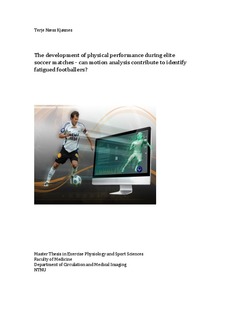| dc.description.abstract | Background: The physical performance of soccer players at the end of matches, measured by motion analysis variables, could potentially contribute to identify how fatigued they are. Such information would be valuable for the coaching staff in order to optimize the players’ training load and avoid injuries in the following days. Further knowledge regarding the development of physical performance during competitive games is, however, needed.
Purpose: The aim of this study was to investigate the development of physical performance variables during elite soccer matches, to compare end-game work rate of substitutes with players starting the game and to analyse if the need for a goal affected physical performance in the latter part of matches.
Methods: 47 footballers playing for a top-level team in the Norwegian elite division were monitored during 64 domestic league matches. A local positioning system was used to measure acceleration frequency (ACCfreq) and distance covered in total (TDC), by highspeed running (HSR) and when sprinting (DCS), whereas triaxial accelerometers quantified player load (PL).
Results: All physical performance variables were significantly reduced in the final 15-min compared to the first 15-min of matches (p<0.01). TDC, ACCfreq and PL were significantly lower in the last 15-min than in all of the other 15-min periods (p<0.05). Substitutes were superior to starters in terms of end-game TDC, HSR, DCS, ACCfreq and PL (p<0.05). The players covered a greater distance in total in the final 15-min of games when they were in need of a goal (losing or drawing) compared to when they were winning (p<0.05), whereas no significant differences were found for HSR, DCS, ACCfreq and PL.
Conclusion: Physical performance is severely compromised at the end of elite soccer matches, and the superior work rate of substitutes compared to starters implies that a substantial amount of the decrements is due to fatigue. Hence, the end-game performance of motion analysis variables could provide information of the players’ physical condition if interpreted in a context where the awareness of situational confounders is present. | nb_NO |
